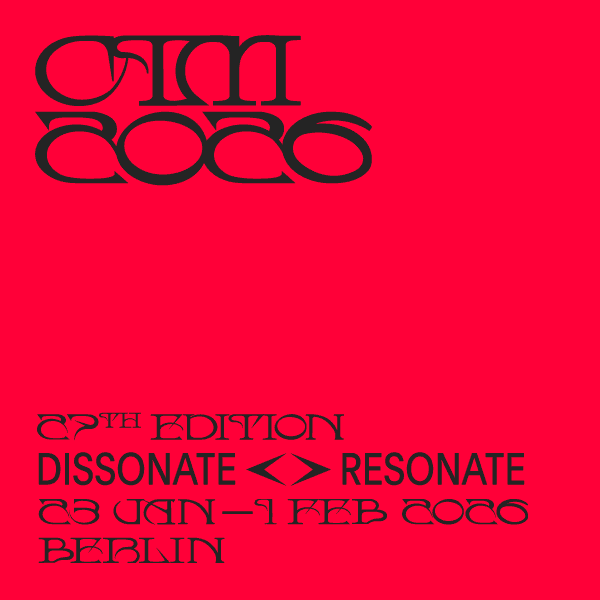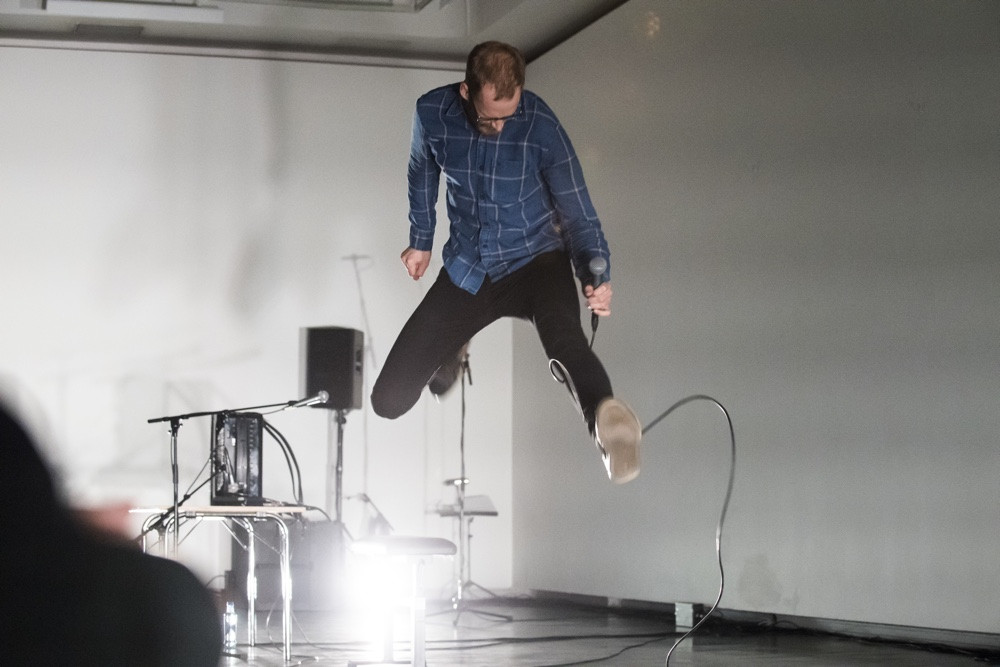
Borealis 2017: A Joyful Noise
It is a little after one in the afternoon and the flat, northern light is streaming through the wall-spanning picture windows of Bergen Kunsthall’s upper floor. Before a few dozen still-bleary-eyed festival-goers, Okkyung Lee is talking about the social function of music. “Before,” she says, “I didn’t think about it.” That “before”, for the Korean-born, New York-resident cellist, composer, and improviser, refers to the election of Donald Trump last November. “But nowadays,” she continues, “I think we all do.”
’The World is Shit. Why do we do this?’
It’s the third day of the Borealis Festival and Lee is sitting on a panel called ‘The world is shit. Why do we do this?’ The title, according to the festival’s artistic director Peter Meanwell, came from an earlier conversation between himself and Lee “with a few more curse words than we put in the programme.” The hour-and-a-half long talk is by turns inspiring and depressing, amiable and ireful. But its themes will subtly pervade the whole weekend, across a series of concerts which couldn’t help reflecting (and railing against) the peculiar contemporary world situation, almost despite themselves.
From the Thursday night improvised set by Lee herself to the final evening’s tender tribute to Pauline Oliveros from Oliver Coates and Lawrence Lek, Borealis felt galvanised and deeply moving, yet suffused with an inescapable warmth. Rarely has such anger, pain, and loss been presented so congenially.
Meditation on historical memory and erasure
Downstairs on the Kunsthall’s ground floor, Matana Roberts’s installation, I Call America, running continuously throughout the festival, consists of a complex patchwork of archival material with Roberts’ own scores and painting. Spread across two vitrines, two large wall-sized tapestries, and a looping video, each one more intricate and kaleidoscopic than the last, Roberts’ work is at once a profound meditation on historical memory and erasure, in which freight trains and fragments of folk songs criss-cross with sepia-toned photographs of shell-shocked migrants, and a highly indeterminate and open performance score.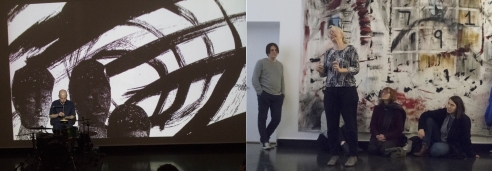 Walshe og Corsano optræder i Matana Roberts installation I Call America
Walshe og Corsano optræder i Matana Roberts installation I Call America
It is in this latter role that the exhibition becomes the site of a series of ‘interventions’ over the course of the weekend, welcoming performance from drummer Chris Corsano, violinist Angharad Davies, and, first of all, singer-composer Jennifer Walshe. Walshe’s interpretation focuses on the analogue undercurrent of Roberts’ digitally-composited montages, drifting between quavering sung tones and throaty white noise to sound, by turns, like a radio caught between stations or a gramophone on the blink. The extraordinary elasticity of her voice proves the perfect foil for the rich counterpoint of meaning present in the original installation, stuttering and choking on sounds like ill-concealed scars.
Taken by the stage
Later in the evening, a new composition by Walshe provides accordionist Andreas Borregaard with the occasion for one of the most ecstatic – not to say eccentric – performances of the festival. Borregaard strides onto the stage. He does not stroll on, or saunter on. Certainly he does not take the stage. If anything the stage takes him. He moves quickly and intently, almost hyperventilating, then stands facing his instrument on its table for some minutes, brow furrowed, as if willing it to do the show for him or psyching himself up for something. He has the demeanour of a man about to participate in a sporting event, or deliver a motivational lecture, or propose marriage – and there are elements of all three such performance genres (and many others) in what follows.
Over the next 30 minutes, Borregaard will run to and fro and kick and jump, play new age music from a cassette deck and single out members of the audience (“You know what I’m talking about!”), and hoarsely confess deeply-felt feelings. He will also, intermittently, play some florid and virtuosic passages on the keys of his accordion. But much less than these traditionally-scored notes, Self-Care is about bringing the performance’s outsides into its insides, and about the abrasive mismatch between a given content and its form of presentation: like watching a man striking Van Halen poses, scissor-kicking and air-pumping, while reciting the words of the application form for British permanent residency (a bureaucratic ordeal for many, post-Brexit). Self-Care comes across, finally, like a frantic scrabbling about, a mad grab at trying to make sense of an increasingly perverse world with whatever means (and memes) are at hand. It’s thrilling, sometimes confounding, and very funny.
Markings of fragile territories
But the evening’s knock-out blow comes from Okkyung Lee’s closing performance. She starts playing halfway up the stairs with a series of long, keening bow strokes that seem to imitate the foghorns from the boats in the harbour down the road, that I had heard all day echoing against the city streets. Gradually, she journeyed up to her advertised venue, cradling the cello’s neck between her chin and shoulder, scraping the bow against the strings and the spike against the stone floor in a series of harsh, guttural, sweeping motions, in comparison to which fingernails on a blackboard sound like Tchaikovsky.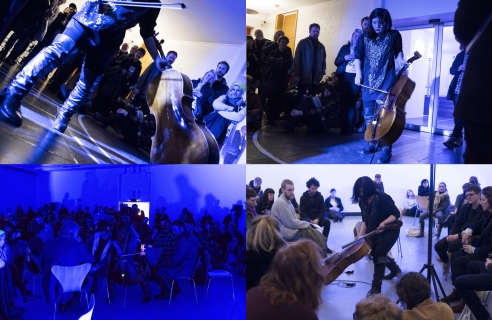 Okkyung Lee på Borealis, 2017
Okkyung Lee på Borealis, 2017
It is more than ten minutes into the set by the time we make it into a Tårnsalen bathed in blue light, chairs arranged haphazardly about the space, seemingly at random. It taking a little while for the crowd to follow the cellist through the bottleneck of the doorway, by the time I make it into the room, Lee is engaged in a battle of wills with a member of the audience, shoving backwards against his chair as she continues to saw and hammer indefatigably against her instrument.
Eventually finding a place on a stool in the middle of the room, Lee casts aside one now-ragged bow in favour of another and plugs in, without pausing her playing. Now amplified, the sound grows into a roaring susurrus sweeping about the room’s quadrophonic sound system and engulfing the audience in a static violence more akin to the chewed-up electronics of Wolf Eyes than anything in the standard cello repertoire. Suddenly this sound is sucked away and the set ends with the dry whisper of Lee’s cello spike delicately tracing out rings on the floor, like a determined marking of fragile territory.
Friday evening finds the Borealis crowd huddled in a pedestrian tunnel under Bergen’s central bus station. Jonáš Gruska’s Passage rumbles and trembles down the narrow confines of the underpass as the Slovakian sound artist squats, almost immobile, over a laptop precariously balanced on a mound of cables and interfaces. The sound is diffused via resonating speakers attached limpet-like to the walls, making the panels themselves into their PA system. While the composition playing through this unusual set-up soon descends into a hocket of little bleeps and blips, like Steve Reich played on Gameboys, the sound is best precisely at those moments when it least resembles hi-fi, fluttering with all sorts of weird material resistances.
Matrix of possibilities
There is a peculiar gait employed by those who deign to patrol the space of a concert hall during such works as invite their audience to walk about during the performance. Lolling but hesitant, always solitary and serious-faced, they look a little like movie somnambulists. But such studied perambulations are hardly necessary to the appreciation of Lemuria, a new work by Norwegian improvising group LEMUR, for so successfully did it evoke, by its own means, a sense of movement, narrative, and far-off places.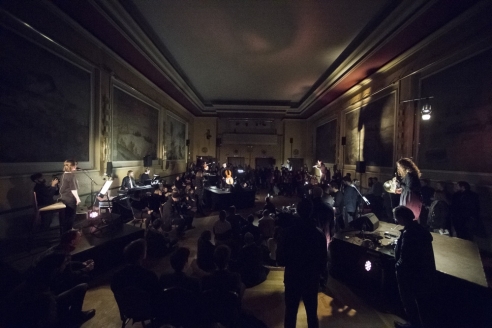 Lemur, Borealis 2017
Lemur, Borealis 2017
Inspired by Luigi Nono’s Guai ai gelidi mostri and the spurious ‘lost continent’ proposed by Victorian zoologist, Philip Sclater, the piece sees LEMUR’s four regular members (flautist Bjørnar Habbestad, cellist Lene Grenager, horn player Hild Sofie Tafjord, and double bassist Michael Francis Duch) and two additional vocalists (Unni Løvlid and Stine Janvin Motland) dispersed amongst six ‘islands’ throughout the concert hall at Grandbergen, following a loose score, more like a matrix of possibilities than precisely encoded instruction, governing pauses and processes rather than specific notes. Listening to Duch tenderly pluck at his bass strings, letting them rattle against the screw of his bow, and the always-otherworldly voice of Stine Janvin Motland, I feel myself transported, temporarily, dreaming of other worlds.
A protest against forgetting
Espen Sommer Eide and Signe Lidén’s proposition is simple: for too long we have thought of music as essentially horizontal, on a score read from left to right, or flowing from speakers through space to the ear. But what if we were conceive it instead as vertical. Their Vertical Studies, the result of a weeks-long research residency at Fjell Festning, a WWII-era concrete hilltop fort, finds the pair contemplating sonic strata, from the lithospheric silence to the resonant wind frequency of tall buildings. For their concert, they usher us into the central turret of the fort and play a composition of processed field recordings through upward-facing speakers in long extendable tubes. Afterwards, we all stand out on the hill, immersing ourselves in the sound of their mobile sound sculptures, like kites bereft of their canvas, their rubber strings humming polyphonically in the breeze.
Later that night, Moor Mother (aka Camae Ayewa) is on stage at the Kunsthall bar, Landmark, delivering her “end of the world speech: Fuck you! Fuck you! You’re cool –” she is pointing out individual audience members in turn “– fuck you! Where’s Joe? He’s cool…” About twenty minutes earlier, her set had kicked off with a loop of Public Enemy’s ‘Bring the Noise’, Chuck D chanting “Bass! How low can you go?” as Ayewa swipes at a theremin.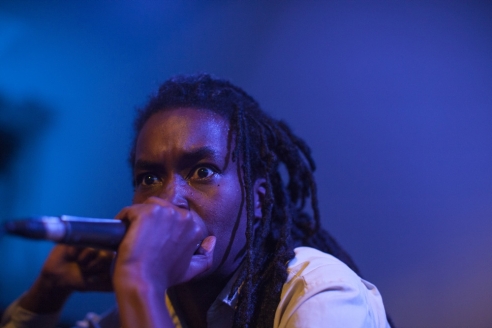 Moor Mother, Borealis 2017
Moor Mother, Borealis 2017
For the best part of an hour, Moor Mother’s set swerves between noise poetry, brutal electronica, urgent hip hop, and angry harangues directed at the audience. In a set that references centuries of oppression, from slave ships to the Philadelphia Move bombing, to the Ferguson unrest of 2014, Ayewa delivers with the intensity of a great actor, laughing manically one minute and close to tears the next. I am reminded, more than once, of Heath Ledger’s role as The Joker in The Dark Knight. But more than just a performance, Moor Mother’s set is an event, a visceral protest against forgetting, delivered in a heavy cloud of astringent noise and fractured beats.
The ghost of Oliveros
Pauline Oliveros died last November at the age of 84, but her digital ghost makes an appearance, delivering a lecture in a strange virtual world, on the screen behind Oliver Coates and Lawrence Lek’s sunlight ray of Heliotones. Accompanied by the junior choir of Bergens Domkirkes, the piece reaches an almost unbearably tender conclusion as the whole audience is enjoined, by the disembodied voice of Oliveros herself, into a rendition of her Tuning Meditation, singing long tones, in and out of harmony with whatever you can hear in the room. Producing a rich, drifting cocoon of sound, the experience leaves us all with heavy hearts, immeasurably warmed.
The final night of the festival reaches a stunning conclusion with a collaboration between four of the world’s top improvising musicians: Okkyung Lee, Chris Corsano, Rhodri Davies, and Angharad Davies. Between Corsano’s octupus-limbed drumming, Lee’s febrile extended cello techniques, Rhodri Davies playing the harp like a no wave guitarist, and his sister Angharad’s intensely focused violin playing, they build up a sound both taut and tender, punctuated by each musician taking turns to walk to the centre of the room and type into a computer, its screen projected onto the wall, the answers to questions asked beforehand of the audience. “Is experimental music overrated?” one question demanded. “Nope,” came its succinct reply.
After the show, I ask Rhodri Davies to what extent these questions and answers were determining their playing. “Well, I was reading them,” Davies replied, “so I suppose in that sense, it must have seeped through and had some kind of influence.” He’s right, of course. However much we might like to see music as another world, the outside world keeps seeping through, as this weekend’s performances showed time and again.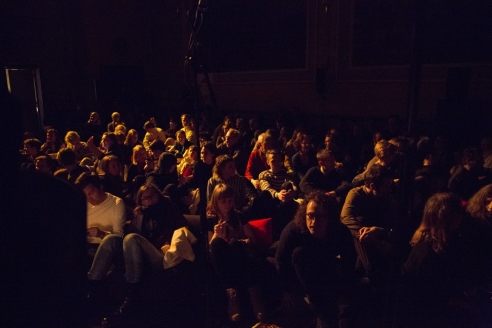 Heliotones, Borealis 2017
Heliotones, Borealis 2017
